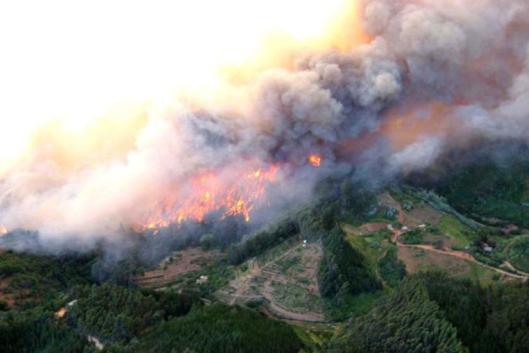In early 2012, voracious fires swept through thousands of hectares in various regions of Chile, including la Araucanía and Bío Bío, in central-southern Chile. It is in these regions and Maule, which are also the regions with the country’s highest rates of unemployment, emigration and poverty, that almost all of the more than three million hectares of industrial plantations of exotic tree species, mainly pine and eucalyptus, are concentrated – thanks to government policies that incentivise their establishment and expansion. The holding companies CMPC (owner of Forestal Mininco S.A.) and Arauco, two of the biggest economic groups in Chile, control 70% of the tree plantation industry, and their plantations have invaded traditional Mapuche indigenous territories (see WRM Bulletin 174). Industrial pine and eucalyptus plantations dry out the land, drain groundwater reserves and generate veritable “deserts” in the sense of a complete absence of plant diversity. These factors, combined with high temperatures and the dryness of the trees’ structures, particularly in the case of pines, create a permanent threat of the breakout of fires.
On that occasion, the fires took a tragic toll that included the deaths of a number of fire fighters. Some government authorities and company owners accused sectors of the Mapuche community of causing the tragedy. For their part, various Mapuche organizations laid direct blame on the companies and stated that this was a campaign orchestrated by political and business sectors who were seeking a means to divert attention away from those who were truly responsible, as well as a blatantly racist attempt to step up the criminalization and stigmatization of indigenous communities demanding their rights and/or defending their territories.
On April 12, 2014, the threat of fire posed by industrial tree plantations became a tragic reality once again, this time in Valparaíso. The fire caused 15 deaths, consumed more than 900 hectares and destroyed some 3,000 homes, in a port city surrounded by plantations of exotic and highly flammable tree species that border on its hills and populated areas. According to the news agency Mapuexpress (1), this is a clear example of what has been happening in various parts of central-southern Chile due to the enormous risks created by industrial plantations of pine and eucalyptus trees.
Mary T. Kalin Arroyo, a National Science Prize winner in 2010 and director of the Ecology and Biodiversity Institute of the University of Chile – quoted by Mapuexpress – recently sent a letter to the Opinion section of the newspaper La Tercera, expressing her concern over “the tragedy associated with the fire suffered by Valparaíso this weekend,” which, she said, “obliges us to reflect on its causes and on why it has been so difficult to control.”
On this point, Kalin Arroyo stresses: “One aspect that has received little mention (with regard to the fire in the port) is the composition of the natural vegetation of the hills of Valparaíso, which is typical Chilean scrubland, which may be flammable, but not as much as the exotic species (eucalyptus, pine and acacia) that have been planted in the area. Eucalyptus globulus is considered one of the world’s most fire-prone plants. The leaves contain volatile compounds that produce explosive fires locally. Once it catches fire, the bark separates from the tree, causing additional outbreaks. Pine needles have a high resin content. Acacia delata, which is now common in central Chile, is included on the list of the most flammable plants in Tasmania, where it is a native species.” (2)
In the meantime, the online publication el deconcierto commented that the fire that devastated the hills of Valparaíso broke out in an area surrounded by tree plantations owned by the company Forestal Valparaíso S.A. It added: “In addition, species like pine contain and secrete terpenes, a flammable substance that when exposed to heat can spread or ignite fires. Combined with this situation is the lack of safeguards such as firebreaks that are of sufficient size for the conditions in the country, where there are close to 2.9 million hectares of tree plantations between the region of Valparaíso and La Araucanía, of which 68% are industrial plantations of pine trees (Pinus radiate) and 23% are of eucalyptus (Eucalyptus spp.).” (3)
The tree plantation industry and some political sectors have plans to double the area of industrial tree plantations in Chile. But they would be well advised to consider what Mary T. Kalin Arroyo warns in her letter: “There are lessons that must be drawn from this.”
This article is based on information from the following sources:
(1) “Incendio en Valparaíso ¿Más expansión de pinos y eucalpitus?”, Mapuexpress,http://mapuexpress.org/
(2) “Incendio en Valparaíso”, http://www.latercera.com/
(3) “Incendio en Valparaíso: las responsabilidades del sector forestal”, http://eldesconcierto.cl/
